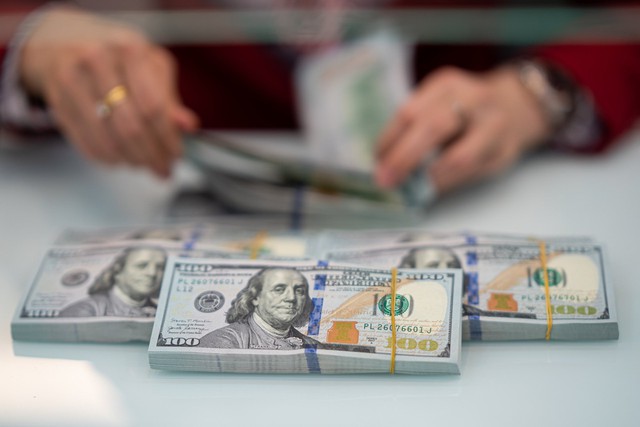
On April 16, the State Bank of Vietnam announced the central exchange rate at VND 24,141 to the USD, an increase of 45 dong compared to yesterday. With a margin of +/-5%, the floor and ceiling exchange rates applicable to commercial banks are VND 22,934 – 25,348 to the USD.
The USD price at banks today continued to increase sharply, reaching the allowable ceiling. Specifically, at Vietcombank, the USD price increased by 48 dong to VND 24,978 – 25,348. VietinBank increased sharply by 70 dong in the purchase price and increased the selling price to the ceiling of VND 25,348/USD. BIDV also increased by 47 dong in both trading directions, buying and selling at VND 25,036 – 25,346/USD.
In a recent analysis report, KB Securities Vietnam (KBSV) believes that the interbank exchange rate in the first quarter of 2024 increased strongly, mainly due to the increase in the DXY index, increasing import demand, and USD hoarding activities as well as carry trade. The State Bank of Vietnam, although recognizing the pressure from the beginning of the year, has proactively issued bonds since the beginning of March but has not achieved the desired result. “We believe that the reason why this bond issuance became less effective is because this move only affects the carry trade activities of banks, while the demand for USD settlement for imports and export activities but delayed, hoarding USD still continues,” the group of analysts commented.
According to KBSV’s assessment, the first half of 2023 is still a difficult period for the State Bank of Vietnam in its exchange rate management, especially when in addition to the existing pressures from 2023, there is also additional pressure from gold price developments. However, when compared to the currencies of other countries in the region, the VND is still maintaining a depreciation rate equivalent to the CNY, KRW, and THB.
In the baseline scenario, KBSV believes that the USD/VND exchange rate will continue to face strong pressure in the remaining part of 2024, forecasted to increase by 3% to reach VND 25,000 to the USD because although the overall balance of payments is forecast to be more positive but the pressure from the DXY and the negative interest rate differential between the USD and VND continues with the adjustment of the FED Pivot down to September.
KBSV expects that import and export will recover, forecasting a balance of payments surplus of USD 10 – 12 billion in 2024, due to the fact that import and export activities up to the first quarter of 2024 are more positive and are expected to continue to grow, while the pressure from carry trade activities decreases because the level of interbank interest rates will no longer be as low as in the previous period. Besides, stable and increasing FDI and remittance flows will be a stable source of foreign currency for 2024.
KBSV forecasts that the USD/VND interest rate differential will decrease and help reduce exchange rate pressure, not only reducing the speculative hoarding by enterprises but also reducing the carry trade pressure of the banking system. It is forecasted that the overnight interbank interest rate will remain in the range of 2%-3% in the remaining period of the year. With external pressures from the increase in the DXY, US bond yields and gold prices, the group of experts believes that the State Bank of Vietnam will still focus on issuing bonds. However, if these pressures continue to increase, especially in the scenario that Brent exceeds 93, the US 10-year government bond yield exceeds 4.7%, the State Bank of Vietnam may have to intervene by selling fixed-term or selling direct foreign exchange reserves to stabilize the exchange rate.
At the Workshop on Consultation on the Report “Vietnam Financial Market 2023 and Outlook 2024” on the morning of April 16, Dr. Can Van Luc, Chief Economist of BIDV, said that the recent exchange rate fluctuations were mainly due to the appreciation of the US dollar. Since the beginning of the year, the USD has increased by 4.5%. The US dollar has increased for two reasons: Firstly, the FED seems hesitant to cut interest rates, and secondly, the US economy is not in recession but is recovering better than last year. This has caused the USD to appreciate, and the domestic currencies pegged to the USD have all depreciated in the recent past. He said that the basic supply and demand relationship of foreign currencies in Vietnam is still stable. When the FED starts to cut interest rates, possibly from the third quarter, the exchange rate will immediately be less pressured. It is forecasted that the exchange rate may increase by 2.5-3% this year.
Answering the question of whether the State Bank of Vietnam is likely to sell foreign currencies, Mr. Luc said that the State Bank of Vietnam will have to make careful calculations because it is also related to gold imports, and the State Bank of Vietnam will have to calculate how much to import so as not to affect foreign exchange reserves. Of course, if the foreign exchange market fluctuates strongly, the State Bank of Vietnam will also be ready to intervene, using various resources. “I believe that the State Bank of Vietnam has the experience to handle this issue. For example, issuing bonds is also a way to increase interest rates on the interbank market to reduce the interest rate differential between USD and VND, and also reducing the exchange rate pressure in the recent past,” said Mr. Luc.





































